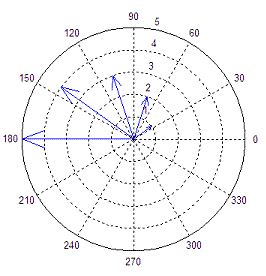我可以轻松使用ggplot2绘制下面的图表:

实际上,我的数据如下:
degree value 1 120 0.50 2 30 0.20 3 -120 0.20 4 60 0.50 5 150 0.40 6 -90 0.14 7 -60 0.50 8 0 0.60
第一列是度数(从-180到180或从0到360),第二列是相应的值。因此,我想用箭头从(0,0)指向每个数据点,但使用圆形坐标系,如下所示:
我尝试使用以下代码:
base <- ggplot(polar, aes(x=degree, y=value))
p <- base + coord_polar()
p <- p + geom_segment(aes(x=0, y=0, xend=degree, yend=value ), arrow=arrow(length=unit(0.3,"cm")) )
print(p)
它生成了一个极坐标图,但是我没有从(0,0)到我的数据点得到直线箭头。我尝试使用plotrix包绘制此图,结果如下所示:3 http://rgm2.lab.nig.ac.jp/RGM_results/plotrix:polar.plot/polar.plot_001_med.png。我无法在此图中导入箭头。如何使用plotrix包添加箭头,或者如何使用ggplot2绘制它?

